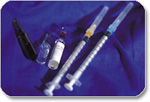
Screening Cut-off: 300 ng/ml
DEA Drug Class: Narcotic
Type: Prescription Drug
Trade Names: Amidone, Diskets, Dolophine, Heptadon, Methadose, Physeptone, Symoron
Street Names: Dollies, Downer, Green, Juice, Meth, Mtd
Drug Information
Methadone (MTD) is a narcotic analgesic prescribed for the management of moderate to severe pain and for the treatment of opiate dependence (heroin, Vicodin, Percocet, Morphine). The pharmacology of Oral Methadone is very different from IV Methadone. Oral Methadone is partially stored in the liver for later use. IV Methadone acts more like heroin. In most states you must go to a pain clinic or a Methadone maintenance clinic to be prescribed Methadone. Methadone is a long acting pain reliever producing effects that last from twelve to forty-eight hours. Ideally, Methadone frees the client from the pressures of obtaining illegal heroin, from the dangers of injection, and from the emotional roller coaster that most opiates produce. Methadone, if taken for long periods and at large doses, can lead to a very long withdrawal period. The withdrawals from Methadone are more prolonged and troublesome than those provoked by heroin cessation, yet the substitution and phased removal of methadone is an acceptable method of detoxification for patients and therapists.
Drug Enforcement Agency (DEA) Drug Classification and Effects Information
Resources